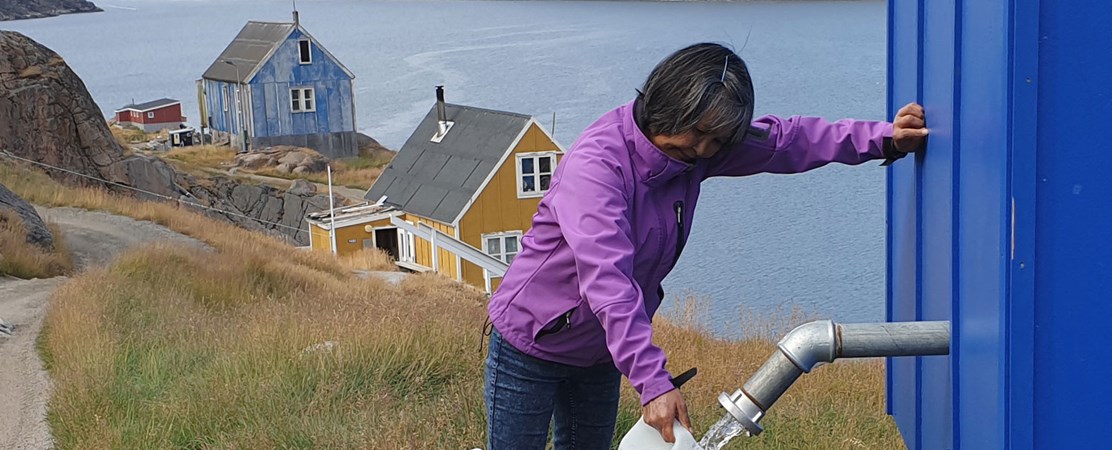Improved Water Access and Sanitary Conditions in Rural Arctic Settlements

By Pernille Erland Jensen, Lead of the UArctic Thematic Network on Arctic WASH, Associate Professor, Technical University of Denmark and Aaron Dotson, Vice-lead of the UArctic Thematic Network on Arctic WASH, Vice Provost for Research, Professor, University of Alaska Anchorage
According to the United Nations, everyone has the right to sufficient, continuous, safe, acceptable, physically accessible, and affordable water for personal and domestic use, i.e. drinking water from an improved water source that is located on premises, available when needed, and free from contamination.
A recent survey on the status of water and sanitation in the circumpolar Arctic reports a significant prevalence of incomplete services in the region compared to the overall national status of Arctic nations. Health studies conducted in the North American Arctic and Subarctic have shown a direct correlation between clean water in sufficient quantities and reductions in the occurrence of illness and hospitalizations due to infectious diseases. These studies show that skin infections, respiratory tract infections, and severe invasive bacterial infections such as meningitis are more common in communities lacking centralized and well-maintained water and sewer service. The current global pandemic situation has more than anything increased our awareness of the importance of sufficient hygienic standards for all.
Release of untreated sewage into the environment is common practice in many Arctic regions. The lack of in-home sanitation systems such as piped sewers or on-site treatment makes the so-called honey-buckets (i.e. a bucket used as a toilet) commonplace. This lack of modern sanitation infrastructure poses additional health threats due to human exposure to untreated sewage and nearby sewage contaminated water. However, when advanced sanitation systems are installed, they tend to pose operational challenges due to climatic and infrastructural conditions.
Though the associated negative health outcomes impose costs that in turn impede socioeconomic development, local and regional governments may not necessarily have the capability to invest in improved central systems, as the capital and operational costs of centralized water and sanitation systems in the Arctic and Subarctic are extremely high. Where they do, rural households typically spend a much higher percentage of their income on water and sewer user fees than an equivalent-sized urban household.
Development of less expensive technologies or adaptation of existing technologies to fit the Arctic conditions is needed. The Intergovernmental Panel on Climate Change (IPCC) report on climate change highlights the tremendous potential for low-cost decentralized technologies such as ecological toilets and separation of greywater from the more contaminated blackwater to provide viable strategies where community acceptance is garnered.
High costs and lack of appropriate technologies are, however, not the only reasons for the deficiencies. Lack of awareness of the importance of modern water and sanitation services also plays a role. Influencers, donors, and decision-makers, even in the Arctic nations, are not aware of the lack of improved water and sanitation services in the rural Arctic. Even when deficiencies are recognized and improvements are determined, there is a lack of awareness of the context that a designed technical solution needs to embody to address the challenges of past and present systems.
In a combined research, innovation and dissemination effort, the UArctic Thematic Network on Arctic Water, Sanitation, and Hygiene (WASH) wishes to act as a catalyst for increased awareness, development of innovative solutions, and informed decision-making on water and sanitation services in the remote Arctic. We do this by offering courses and through development of research projects to elucidate gaps of knowledge.
Our approach is interdisciplinary involving environmental scientists, public health practitioners, medical doctors, engineers, and social scientists. Our engagement is circumpolar to maximize the opportunity to learn from each other across the Arctic and minimize the urge to import solutions from warmer southern climates which have so often proven insufficient.
Since our establishment in 2018, we have hosted more than 150 students from around the globe including Belarus, Cambodia, Canada, China, Denmark, Greenland, India, Kazakhstan, Moldova, Norway, Ukraine, Tajikistan, Russia, Sweden, Switzerland, and the United States in annual summer school courses. We also developed an online course based on the lectures given at the summer schools, freely available to anyone interested to learn. In June 2021, our summer school will take place online due to on-going travel restrictions.
We welcome you to join us by learning from our online content at your own pace, taking part in our summer schools or research projects, or contributing to the Thematic Network as a member.
